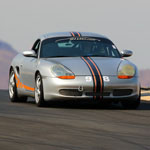Did anyone read the article in the June Motorcyclist comparing helmets and the testing standards? It looked at helmets that met DOT, BSI, ECE 22-05 and Snell 2000 using their own testing gear. They were specifically looking at G's transmitted to the head and their findings were that the Snell 2000 helmets were too hard and actually transmitted too much to the head -- but they held up better. The article recommends using DOT (non-Snell) helmets for motorcycles.
I was just wondering if this information would be taken into account by PCA at the national level or if our standards flow down from a racing body. It seems to me that with an airbag and a car surrounding me I would even want a softer helemt than on a motorcycle.
DOT a better standard than Snell for helmets?
6 posts
• Page 1 of 1
DOT a better standard than Snell for helmets?
Doug Rhoades
964 C2 Cab
964 C2 Cab
- rhoadesco
- Member
- Posts: 12
- Joined: Fri Jan 21, 2005 8:45 pm
- Location: Escondido
Helmets
At the risk of overstepping my helmet knowledge, I think you are looking at apples and oranges. The Snell foundation was founded after the death of a racer Pete Snell from head injuries and is dedicated to helmet safety. They set the standard for helmets in motorsports as well as motorcycling and bikes. They also require testing and certification by the manufacturers before they can be certified.
DOT is a lower standard set by the Dept. of transportation, and is on the honor system. The manufacturers tell the DOT that they meet the standards and are certified, subject to rare random testing. Many of the "beanie" motrocycle helmets are DOT certified, (and probably would not meet the standards), but not Snell tested or certified.
If you are using a helmet for protection, you want a Snell cetified helmet, probably the latest available, SA-2000 now and soon to be the SA-2005.
The ZOne 8 regs also allow the motorcycle helmets M-2000 to be used. The 1995 helmets are soon to be outmoded when the 2005 standard comes out
Greg
DOT is a lower standard set by the Dept. of transportation, and is on the honor system. The manufacturers tell the DOT that they meet the standards and are certified, subject to rare random testing. Many of the "beanie" motrocycle helmets are DOT certified, (and probably would not meet the standards), but not Snell tested or certified.
If you are using a helmet for protection, you want a Snell cetified helmet, probably the latest available, SA-2000 now and soon to be the SA-2005.
The ZOne 8 regs also allow the motorcycle helmets M-2000 to be used. The 1995 helmets are soon to be outmoded when the 2005 standard comes out
Greg
-

Greg Phillips - Pro Racer
- Posts: 1554
- Joined: Wed Jun 30, 2004 11:41 am
- Location: Coronado
Still think it is a worthwhile debate
I'm not sure I see the apples vs oranges aspect. There are a variety of governing standards out there, some voluntary, some not. I was looking specifically at the tests being performed by these bodies and what was more realistic. The current Snell tests force helmet designers to make a harder shell that stands up to a repeat blow. The DOT, BSI and ECE tests allow the helmet to absorb much more force of the first blow thereby transmitting less G's to the head.
I am not talking about beanie helmets or trying to compare those to full-face. I use a full-face and I have seen posts in this forum where others prefer something different. The articles I have read all compare full-face helmets against one another.
The motorcycle press has been critical of the amount of G's allowed to the head by the Snell test (300 G's) and in the article the foundation says they are looking into a further reduction.
I am not bashing Snell. I think they have done and are doing great work. I am just saying that when I make my decisions I like to have all available information. I thought it was an enlightening article and was wondering if the auto racing crowd was as involved in these debates as the motorcyclists.
I am not talking about beanie helmets or trying to compare those to full-face. I use a full-face and I have seen posts in this forum where others prefer something different. The articles I have read all compare full-face helmets against one another.
The motorcycle press has been critical of the amount of G's allowed to the head by the Snell test (300 G's) and in the article the foundation says they are looking into a further reduction.
I am not bashing Snell. I think they have done and are doing great work. I am just saying that when I make my decisions I like to have all available information. I thought it was an enlightening article and was wondering if the auto racing crowd was as involved in these debates as the motorcyclists.
Doug Rhoades
964 C2 Cab
964 C2 Cab
- rhoadesco
- Member
- Posts: 12
- Joined: Fri Jan 21, 2005 8:45 pm
- Location: Escondido
Helmet
I see apples to oranges.
M and SA ratings are two different things. How different, I'm not sure. An M2000 helmet may be 'too hard' but it doesn't necessarily follow that a SA2000 helmet is too hard.
Also, the conditions of a motorcycle wreck are much different than a car wreck. Generally, the type of objects an M helmet might hit can be far ranging -- whatever is out there in the world. What the SA helmet might hit is most likely limited to what is inside the car.
Generally, an M helmet is expected to take a six foot fall with your head in it just once. Under normal operating conditions, an M helmet should not come into contact with any other object during its lifetime. (Unless you're an idiot such as myself and drop your helmet off the folding chair onto the asphalt parking lot during an AX.)
Given that, I'm betting that an SA helmet is 'harder' than M because an SA helmet is built to encounter occasional contact with hard bits inside a car.
Also, I suspect sanctioning bodies require a specific specification as a built in expiration date to make sure helmets haven't been too abused and fit properly.
M and SA ratings are two different things. How different, I'm not sure. An M2000 helmet may be 'too hard' but it doesn't necessarily follow that a SA2000 helmet is too hard.
Also, the conditions of a motorcycle wreck are much different than a car wreck. Generally, the type of objects an M helmet might hit can be far ranging -- whatever is out there in the world. What the SA helmet might hit is most likely limited to what is inside the car.
Generally, an M helmet is expected to take a six foot fall with your head in it just once. Under normal operating conditions, an M helmet should not come into contact with any other object during its lifetime. (Unless you're an idiot such as myself and drop your helmet off the folding chair onto the asphalt parking lot during an AX.)
Given that, I'm betting that an SA helmet is 'harder' than M because an SA helmet is built to encounter occasional contact with hard bits inside a car.
Also, I suspect sanctioning bodies require a specific specification as a built in expiration date to make sure helmets haven't been too abused and fit properly.
-

Mark Garriott - Autocrosser
- Posts: 59
- Joined: Fri Apr 08, 2005 4:32 pm
IMO I think any equipment rated by Snell, M, SA, SFI and FIA are far more safer than anything DOT safe. DOT is the minimum for road standards; and if the equipment rated by racing safety associations is safer, hell I'd choose that anyday over DOT.
Andy Serrato AKA "MONGO"
1986 Porsche 944 #382 Up For Sale - Inquire Within!
1987 Porsche 928 S4 If it's too loud, you're too old!
1986 Porsche 944 #382 Up For Sale - Inquire Within!
1987 Porsche 928 S4 If it's too loud, you're too old!

-

TheStig - Time Trialer
- Posts: 241
- Joined: Tue Oct 05, 2004 10:28 pm
thanks, I learned something.
Enlightening. I didn't know that SA2000 extended the M2000 spec with flame retardance and other automobile-related standards. Good to know.
I still like to see actual tests and standards individually vice a blanket approval by some authority -- but that's just my rebel nature. For my money I would still rather have a softer helmet that provides more cushion to the first blow -- that's the one I'm most concerned with.
I still like to see actual tests and standards individually vice a blanket approval by some authority -- but that's just my rebel nature. For my money I would still rather have a softer helmet that provides more cushion to the first blow -- that's the one I'm most concerned with.
Doug Rhoades
964 C2 Cab
964 C2 Cab
- rhoadesco
- Member
- Posts: 12
- Joined: Fri Jan 21, 2005 8:45 pm
- Location: Escondido
6 posts
• Page 1 of 1
Who is online
Users browsing this forum: No registered users and 229 guests
